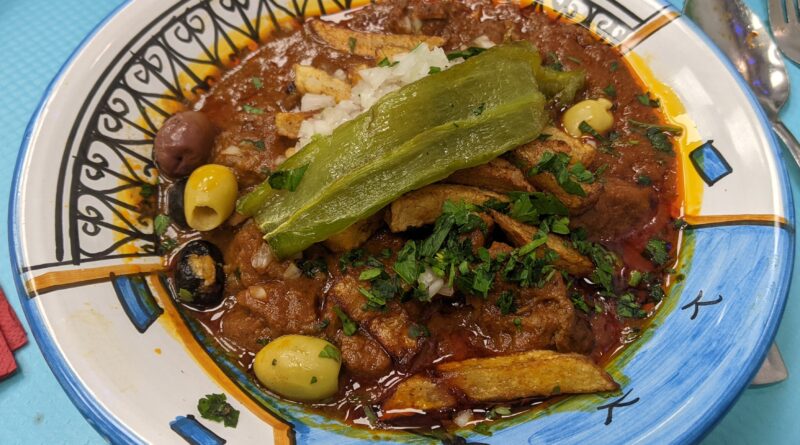Kamounia (Arabic: كمونية), Kamouneya
Exploring the Richness of Kamounia: A Culinary Journey Through Tunisian Cuisine
Introduction: Tunisian cuisine is a delightful amalgamation of flavors, aromas, and traditions that have been passed down through generations. Among its many culinary treasures, Kamounia stands out as a dish that encapsulates the essence of Tunisian cooking. This hearty and flavorful stew has deep roots in Tunisian culture, with a history as rich as its taste. Join me as we delve into the world of Kamounia, exploring its origins, ingredients, preparation, and significance in Tunisian cuisine.
Origins and History: Kamounia traces its origins back to Tunisia, a country nestled in North Africa with a diverse culinary heritage influenced by Mediterranean, Arab, Berber, and Ottoman cuisines. The name “Kamounia” is derived from the Arabic word “kamoun,” which means cumin, a key spice in this dish. While its exact origin story is unclear, Kamounia has been a beloved staple in Tunisian households for centuries, evolving over time through cultural exchanges and culinary innovations.
Ingredients: One of the defining features of Kamounia is its rich blend of spices and tender meat, creating a symphony of flavors that tantalize the taste buds. The core ingredients typically include:
- Beef or lamb: Kamounia is traditionally made with cuts of beef or lamb, which are simmered to perfection, resulting in melt-in-your-mouth tenderness.
- Cumin: As the namesake spice, cumin plays a starring role in Kamounia, imparting earthy and aromatic notes to the dish.
- Garlic: Garlic adds depth and pungency to the stew, enhancing its savory profile.
- Tomato paste: Tomato paste lends a vibrant color and tangy sweetness to Kamounia, balancing the richness of the meat and spices.
- Onions: Onions provide a savory base for the stew, adding sweetness and complexity to the flavor profile.
- Paprika: Paprika contributes a subtle smokiness and mild heat, complementing the other spices in the dish.
- Olive oil: Tunisian cuisine is renowned for its use of olive oil, which adds richness and depth to Kamounia.
- Harissa (optional): For those who crave an extra kick of heat, harissa, a fiery Tunisian chili paste, can be added to the stew to elevate its spiciness.
Preparation: The preparation of Kamounia is a labor of love, requiring patience, skill, and attention to detail. Here’s a simplified version of the cooking process:
- Start by seasoning the meat with salt, pepper, and a generous amount of ground cumin.
- In a large pot or Dutch oven, heat olive oil over medium heat and add chopped onions and minced garlic. Sauté until softened and fragrant.
- Add the seasoned meat to the pot and brown it on all sides, allowing the flavors to develop.
- Once the meat is browned, stir in tomato paste, paprika, and any additional spices or seasonings of your choice.
- Pour in enough water or beef broth to cover the meat, then bring the stew to a gentle simmer.
- Cover the pot and let the Kamounia simmer slowly over low heat for at least an hour, allowing the meat to become tender and the flavors to meld together.
- Taste and adjust the seasoning as needed, adding more cumin, salt, or spices to suit your preferences.
- Serve the Kamounia hot, garnished with fresh herbs such as parsley or cilantro, and accompanied by crusty bread or couscous for a complete meal.
Significance in Tunisian Cuisine: Kamounia holds a special place in Tunisian cuisine, serving as a comforting and nourishing meal that brings families and communities together. It is often prepared for festive occasions such as weddings, religious holidays, and family gatherings, symbolizing hospitality, generosity, and tradition. The aromatic aroma of Kamounia simmering on the stove evokes feelings of warmth and togetherness, inviting loved ones to gather around the table and share in a communal culinary experience.
Beyond its cultural significance, Kamounia also reflects Tunisia’s agricultural abundance and culinary ingenuity. The use of locally sourced ingredients such as olive oil, tomatoes, and spices highlights the country’s rich culinary heritage and deep connection to the land. Moreover, the slow cooking method employed in preparing Kamounia speaks to Tunisian culinary traditions, which prioritize patience, mindfulness, and the art of savoring each bite.
Conclusion: In conclusion, Kamounia is more than just a dish – it’s a culinary masterpiece that embodies the soul of Tunisian cuisine. With its robust flavors, tender meat, and aromatic spices, Kamounia delights the senses and nourishes the body, leaving a lasting impression on all who have the pleasure of tasting it. Whether enjoyed at a family dinner or a festive celebration, Kamounia invites us to embrace the joys of food, culture, and community, uniting us in a shared appreciation for the culinary treasures of Tunisia. So, the next time you’re craving a taste of North African cuisine, why not whip up a batch of Kamounia and embark on your own gastronomic adventure? Your taste buds will thank you for it!



